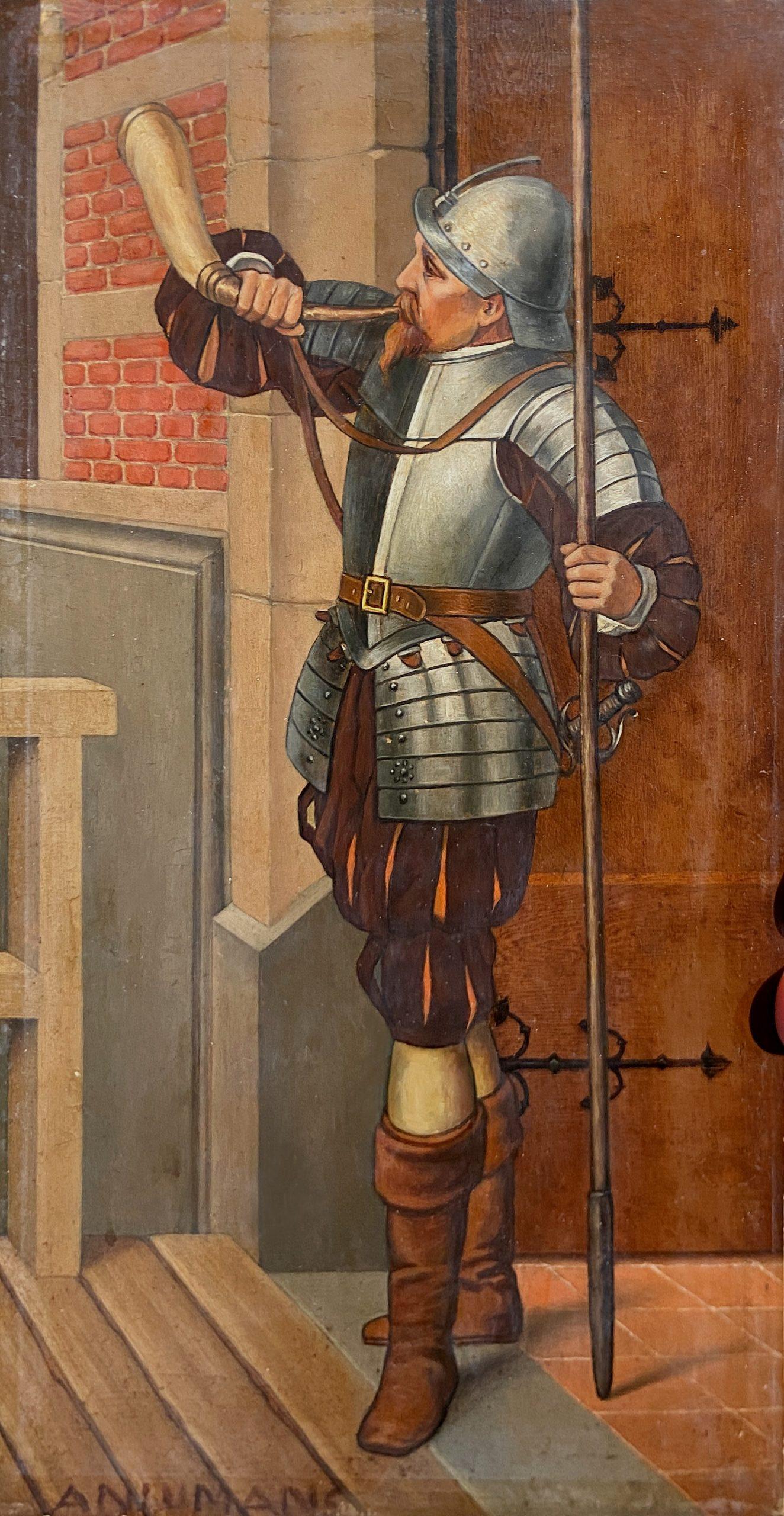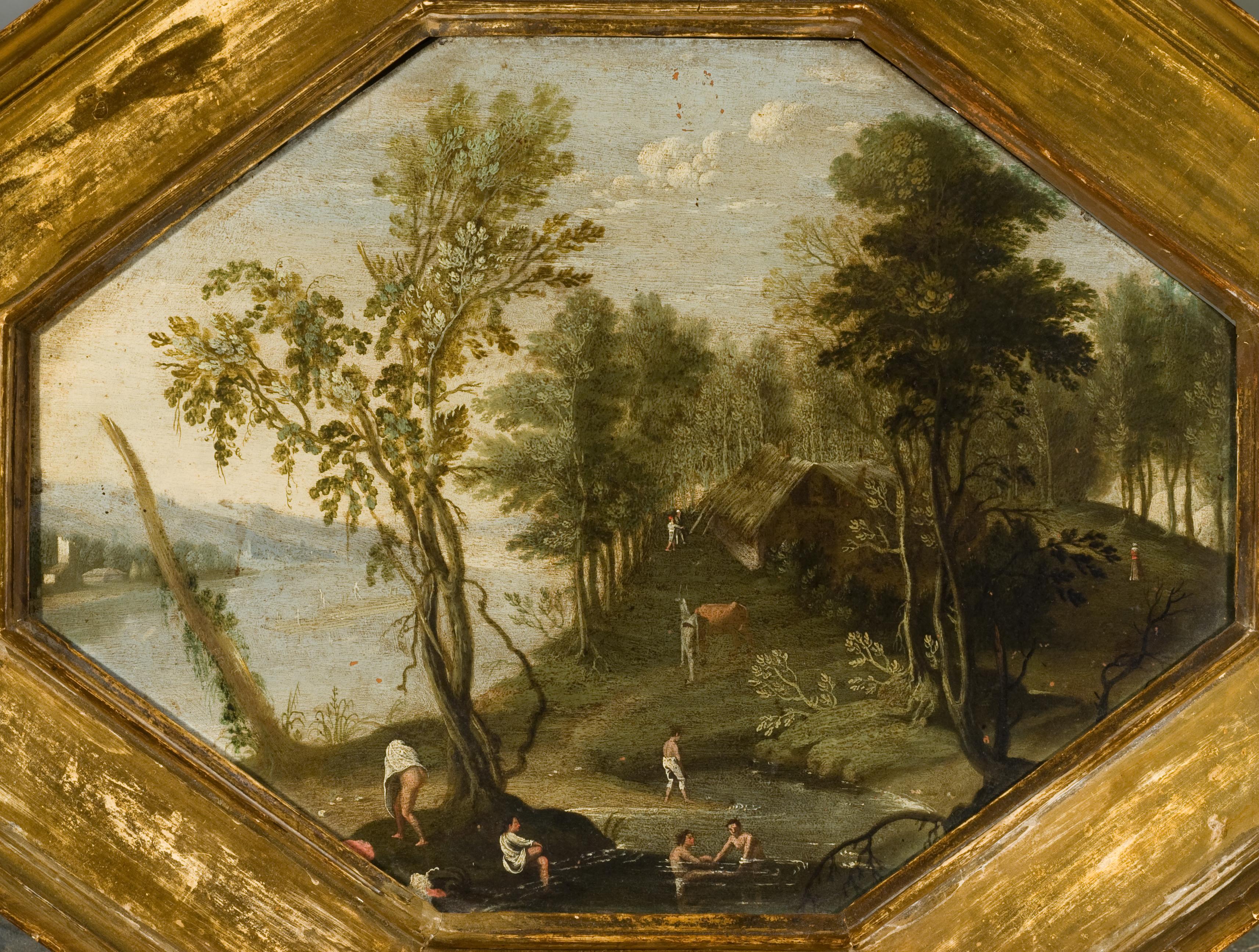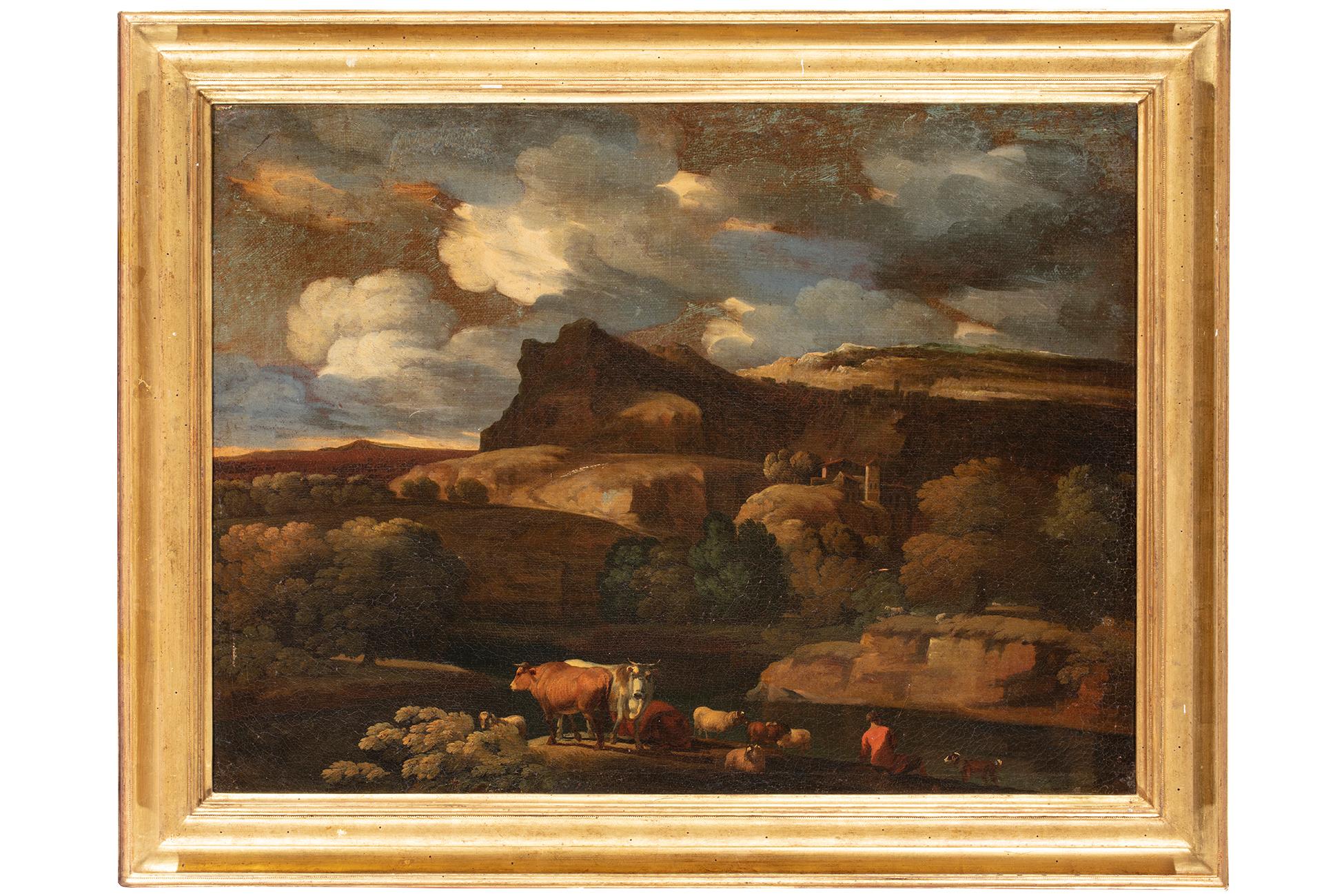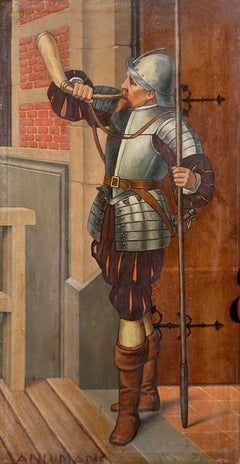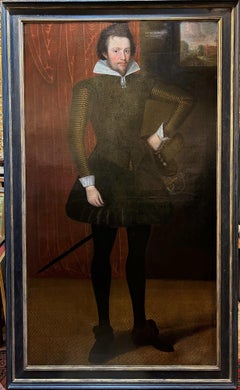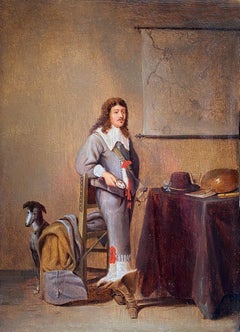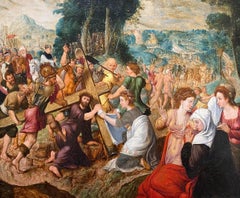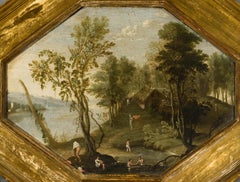Items Similar to Landscape, Oil on Oak Panel, 17th Century
Want more images or videos?
Request additional images or videos from the seller
1 of 5
Studio of Jan Brueghel the YoungerLandscape, Oil on Oak Panel, 17th Century
Price Upon Request
Price Upon Request
Price Upon Request
Price Upon Request
Price Upon Request
Price Upon Request
Price Upon Request
Price Upon Request
Price Upon Request
Price Upon Request
About the Item
Oil on oak panel
Image size: 24 1/2 x 41 1/4 inches (62.25 x 104.75 cm)
19th Century Handmade frame
POA
Jan Brueghel the Younger
Jan Brueghel the Younger devoted his career to carrying on his father's painting style. Demand was high for big, decorative landscapes and works by fijnschilders, painters of meticulous detail, who worked in the vein of Jan Brueghel the Elder. To satisfy the market, Jan the Younger sometimes copied his father's works and sold them under his father's signature. In consequence, it is often difficult to distinguish their styles, though Jan the Younger's few dated pictures show lighter colors and less precise drawing.
After training under his father, Jan the Younger went to Italy in 1624, traveling with his childhood friend Anthony van Dyck. When Jan the Elder died suddenly in a cholera epidemic, Jan the Younger took over his father's busy Antwerp studio. He became dean of Antwerp's guild in 1630. His clients included the Austrian and French courts, and he may have visited France in the 1650s. While Jan the Younger painted many subjects, he is best known for landscapes whose subjects ranged from villages, to mythological scenes, to allegories and, to a new category, animals in landscapes. His allegories depicted the senses, the elements, the seasons, and abundance. Like his father, he created landscape backgrounds for many painters, including Peter Paul Rubens and Hendrick van Balen.
About the Seller
5.0
Vetted Professional Seller
Every seller passes strict standards for authenticity and reliability
Established in 2007
1stDibs seller since 2014
82 sales on 1stDibs
Typical response time: 3 hours
- ShippingRetrieving quote...Shipping from: London, United Kingdom
- Return Policy
Authenticity Guarantee
In the unlikely event there’s an issue with an item’s authenticity, contact us within 1 year for a full refund. DetailsMoney-Back Guarantee
If your item is not as described, is damaged in transit, or does not arrive, contact us within 7 days for a full refund. Details24-Hour Cancellation
You have a 24-hour grace period in which to reconsider your purchase, with no questions asked.Vetted Professional Sellers
Our world-class sellers must adhere to strict standards for service and quality, maintaining the integrity of our listings.Price-Match Guarantee
If you find that a seller listed the same item for a lower price elsewhere, we’ll match it.Trusted Global Delivery
Our best-in-class carrier network provides specialized shipping options worldwide, including custom delivery.More From This Seller
View AllThe Palace Guard, Oil on Panel Signed Painting
Located in London, GB
Oil on panel, signed bottom left
Image size: 6 x 11 inches (15.25 x 28 cm)
This painting depicts a 16th century palace guard standing outside of an open door, wearing a set of armou...
Category
19th Century Figurative Paintings
Materials
Oil, Panel
Sir Rowland Cotton (1581 – 1634), Tudor Oil on Canvas, Life Size Painting
Located in London, GB
Oil on original canvas
Image size: 78 1/4 x 44 inches (199 x 112 cm)
Contemporary style frame
Provenance
Sir Rowland Cotton, 1608
Family Descent
Private Collection
Sir Rowland Cot...
Category
17th Century English School Figurative Paintings
Materials
Canvas, Oil
Soldier in an Interior, Early 17th Century Dutch Oil
Located in London, GB
Pieter Symonsz Potter
Dutch 1600 - 1652
Soldier in an Interior
Oil on oak panel, red seal to reverse
Image size: 15 x 10 3/4 inches
Dutch Ebonised frame
Bathed in a well lit roo...
Category
Early 17th Century Old Masters Portrait Paintings
Materials
Oil, Board
The Road to Calvary, Oil on Oak Panel, 16th Century Painting
Located in London, GB
Oil on oak panel
Image size: 20 1/2 x 23 1/2 inches (52 x 60 cm)
Hand made frame
Herri Met de Bles, also known as Henri Blès, Herri de Dinant and Herry de ...
Category
16th Century Figurative Paintings
Materials
Oak, Oil
Portrait of a Man, 17th Century Dutch Oil on Panel Portrait
By Cornelis Dusart
Located in London, GB
Circle of Cornelis Dusart
Dutch 1660 - 1704
Portrait of a Man
Oil on panel
Image size: 7¾ x 5¼ inches
Giltwood frame
Cornelis Dusart
Cornelis ...
Category
17th Century Old Masters Portrait Paintings
Materials
Oil, Panel
Still Life, 17th Century Oil on Panel Painting
Located in London, GB
Oil on panel, monogrammed mid left
Image size: 15 x 12 1/4 inches (38 x 31 cm)
Dutch ripple style frame
Loeding was born in Leiden in around 1637 and was admitted into the Leiden Guild of St Luke in 1664. Like other Dutch cities, Leiden required membership in the guilds in order to sell wares falling under the various specifications. There is no record of his artistic training or influences, but he likely belonged to the circle of artists including Pieter de Ring and Gerrit Dou, who founded and maintained the Guild. Loeding is last registered as a member in 1673.
One of the most versatile genres that emerged from Dutch 17th Century artistic specialisms is that of 'pronkstilleven'; a laden table with a variety of rich textures, like ornate glassware, gilded goblets, exquisite nautilus cups...
Category
Mid-17th Century Still-life Paintings
Materials
Oil, Panel
You May Also Like
Late 16th or early 17th century by Flemish school, Riverscape, Oil on panel
Located in Milano, Lombardia
Flemish School, late 16th/early 17th century
Title: Wide riverscape with bathing figures on the banks of a pond
Year: 1620 ca.
Medium: Oil on panel, octagon frame
Dimensions: witho...
Category
Early 17th Century Dutch School Landscape Paintings
Materials
Oil, Wood Panel
Knight Van Douw Paint Oil on canvas Old master 17/18th Century Flemish Art Italy
By Simon Johannes van Douw (Antwerp c. 1630 - c. 1677)
Located in Riva del Garda, IT
After Simon Johannes van Douw (Antwerp c. 1630 - c. 1677)
The stop of a traveler on horseback near a post station
Oil painting on canvas
45 x 55 cm
In frame cm. 55 x 65
In this pleasant painting, depicting a knight parked near a post station, the Flemish tradition is based on a strong Italianizing sensitivity, especially by observing the setting and its peculiar brightness.
The mixture of genres and the particular style of execution make it easy to trace the authorship back to a Nordic author but active in Rome, or strongly influenced by the style in vogue in the Eternal city, between the seventeenth and eighteenth centuries: we are referring, in in particular, to a follower of the Antwerp Simon Johannes van Douw.
The chromatic elegance and refinement with which he outlines the figures are typical aspects of his painting.
The scene takes place outside a cottage, probably a post office for travelers, where a modest family divides the tasks by assisting the knights. We see a young boy who hands water to the horse before he sets off again, the father is preparing to feed him with straw and the mother who instead takes care of the little son.
The Italian reminiscences, evident in our painting, have been absorbed by many Northern European authors such as Nicolaes Berchem, Philips Wouwerman or Johannes Lingelbach, all inspired by the leader Pieter van Laer...
Category
18th Century Old Masters Paintings
Materials
Oil
$4,218 Sale Price
20% Off
Landscape Hunt Miel Paint 17th Century Oil on canvas Flemish Old master
Located in Riva del Garda, IT
Jan Miel (Antwerp, 1599 - Turin, 1663)
attributable
Return from the Hunt
Oil on canvas (51 x 66 cm Framed 74 x 89 cm)
Tous les détails sont disponibles sur le LIEN suivant
The wor...
Category
17th Century Old Masters Paintings
Materials
Oil
$5,830 Sale Price
20% Off
Flemish Early 17th Century Old Master Oil on Panel Painting Hunting Scene 1620
Located in Portland, OR
A highly important Flemish Old Master oil painting by Peter Van Lint (1609-1690), titled "Preparing for the Hunt", the painting is dated & signed by the artist, 1620. The painting wa...
Category
1620s Old Masters Landscape Paintings
Materials
Oil, Panel
17th Century by Pieter Mulier Landscape Oil on Canvas
By Pieter Mulier known as the Cavalier Tempesta (Haarlem 1637 - Milan 1701)
Located in Milano, Lombardia
Pieter Mulier known as Tempesta (Haarlem, Netherland, 1637 - Milan, Italy, 1701)
Title: Landscape
Medium: Oil on canvas
Dimensions: without frame 49 x 65...
Category
17th Century Old Masters Landscape Paintings
Materials
Canvas, Oil, Cotton Canvas
Huge 1600's Flemish Old Master Oil Painting Tobias & The Angel Baroque Landscape
Located in Cirencester, Gloucestershire
Tobias & The Angel
Flemish Baroque Old Master, circa 1600
circle of Paul Brill (Flemish 1554-1626)
oil painting on canvas, 43.5 x 59.25 inches
condition: very good, restored and read...
Category
Early 17th Century Baroque Landscape Paintings
Materials
Canvas, Oil
$13,366 Sale Price
30% Off
More Ways To Browse
19th Century Oil Paintings Of A Village
17th Century Italian Landscape
17th Century Italian Drawings
17th Century Oak Panels
French Court Scene Paintings
17th Century Village Paintings
Antique Paintings Peter Paul Rubens
Antique Oil Lighter
17th Century Paintings Peter Paul Rubens
Van Balen
Rockport Artists
Water Mill
19century Landscape Oil Painting
Painting Germany Lake
Robert Hudson
Fall Leaves Painting
Original Antique Oil Painting On Board
Vintage Hawaii Signs
